TEA-21: What it Means for
America and Our Wildlife
INTRODUCTION
The Transportation Equity Act for the 21st
Century was enacted June 9, 1998, authorizing
$217 billion for the Federal surface
transportation programs for highways, highway safety,
and transit for the 6-year period 1998-2003.
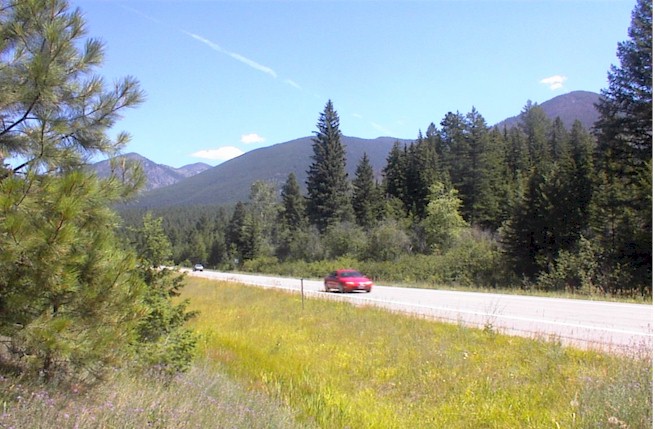
As successor to the Intermodal Surface
Transportation Efficiency Act of 1991 (ISTEA), TEA-21
continued the transformation of our 1950s-era highway
building program into a flexible transportation program.
Both have heralded a revolution in how America executes
transportation policy -- shifting primary responsibility
from the federal government to state and local levels.
More emphasis is placed on building communities than on
building roads. Priorities changed to improved planning,
environmental protection and spending flexibility for
greater transportation choice.
Hallmarks of this new policy include:
-
Flexible funding for highways, transit
and other uses
-
Decisions on spending are made through
inclusive planning at state and local
levels
-
Significant funding is reserved for
maintenance of existing infrastructure
-
Set-aside funds are available for
alternative transportation and measures for
reducing the negative impacts on our
environment
-
Emphasis on public safety
-
Research and technology
TRANSPORTATION AND THE ENVIRONMENT
| For the last century, automobiles and the
roads they require have been the dominant force
shaping the modern American landscape. We have
more cars per capita than any other nation in the
world. Our interstate highway system is unrivaled;
connecting major metropolitan areas and providing
the basis for our transportation
infrastructure. |
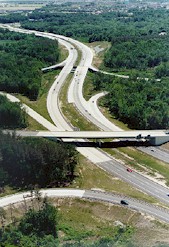
|
However, our
mobility comes with a price. Nearly 4 million miles
of roadways and 200 million vehicles keep Americans
moving, but has had a devastating impact on our
environment. Transportation is the leading source of
overall air pollution; a primary consumer of wetlands;
farmland and open space; and a leading contributor to
solid waste, water pollution and natural resource
consumption.
ISTEA and
TEA-21 have attempted to address these problems, with
the following programs:
§ 1110 CMAQ
($8.1 billion)
The Congestion
Mitigation and Air Quality Improvement program provides
a flexible funding source to State and local governments
for transportation projects and programs to help meet
the requirements of the Clean Air Act. Eligible
activities include transit improvements, travel demand
management strategies, traffic flow improvements, and
public fleet conversions to cleaner fuels, among others.
Funding is available for areas that do not meet the
National Ambient Air Quality Standards (nonattainment
areas), as well as former nonattainment areas that are
now in compliance (maintenance areas). Funds are
distributed to States based on a formula that considers
an area’s population by county and the severity of its
air quality problems within the nonattainment or
maintenance area.
Title VI Ozone
and Particulate Matter Standards (PM)
In 1997,
Congress released new and revised National Ambient Air
Quality Standards (NAAQS) for ozone and particulate
matter (PM). Included in the PM NAAQS were new standards
for PM2.5—fine particles less than 2.5 microns. TEA-21
ensures the establishment of the new monitoring network
for PM2.5 and, within appropriated totals under the
Clean Air Act, requires the Administrator of the
Environmental Protection Agency (EPA) to provide
financial support to the States for 100 percent of the
cost of establishing and operating the
network.
§ 1202 Bicycle
Transportation and Pedestrian Walkways
TEA-21
continues and expands provisions to improve facilities
and safety for bicycles and pedestrians. National
Highways System funds are now available for pedestrian
walkways and consideration of bicyclists and pedestrians
is required in the planning process and facility
design.
§ 1221
Transportation and Community and System Preservation
Pilot Program ($120M)
States, local
governments, and metropolitan planning organizations are
eligible for discretionary grants to improve the
efficiency of transportation systems; reduce
environmental impacts of transportation; reduce the need
for costly future public infrastructure investments;
ensure efficient access to jobs, services, and centers
of trade; and examine private sector development
patterns and investments that support these
goals.
From http://www.fhwa.dot.gov/tea21/sumenvir.htm
TRANSPORTATION
AND WILDLIFE
These programs
address threats to the environment, but are aimed
essentially at the human environment, and do very
little to protect the natural environment, and
wildlife habitat. CMAQ and PM standards are designed to
reduce smog and air pollution in urban areas. Bike and
pedestrian facilities are designed to reduce congestion
on highways. To be sure, smog and pollution have a
negative impact on wildlife habitat. However, roads and
highways impact wildlife on many levels, beyond air and
water pollution.
1. Mortality
from road construction
The actual
construction of a road, from clearing to paving, will
often result in the death of any sessile or slow-moving
organisms in the path of the road. Obviously, trees and
any other vegetation will be removed, as well as any
organisms living in that vegetation.
2. Mortality
from collisions with vehicles
Roadkill is the
greatest directly human-caused source of wildlife
mortality throughout the U.S. More than a million
vertebrates are killed on our roadways every
day.
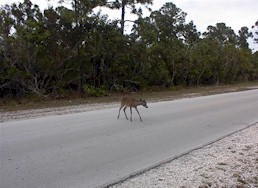
3.
Modification of animal behavior
The presence of
a road may cause wildlife to shift home ranges, and
alter their movement pattern, reproductive behavior,
escape response and physiological state. When roads act
as barriers to movement, they also bar gene flow where
individuals are reluctant to cross for
breeding.
4.
Alteration of the physical environment
A road
transforms the physical conditions on and adjacent to
it, creating edge effects with consequences that extend
beyond the white lines. Roads alter the following
physical characteristics of the environment: soil
density, temperature, soil water content, light, dust,
surface water flow, pattern of run-off, and
sedimentation.
5.
Alteration of the chemical environment
Maintenance and
use of roads contribute at least five different general
classes of chemicals to the environment:
a. Heavy metals
- gasoline additives
b. Salt - de-icing
c. Organic
molecules - dioxins, hydrocarbons
d. Ozone - produced
by vehicles
e. Nutrients – nitrogen
6. Spread of
exotics
Roads provide
opportunities for invasive species by:
a. providing
habitat by altering conditions;
b. stressing or
removing native species; and
c. allowing easier
movement by wild or human vectors.
7. Increased
use of areas by humans
Perhaps the
most pervasive, yet insidious impact of roads is
providing access to natural areas and encouraging
further development. As our cities and towns sprawl
across the landscape, more and more wildlife habitat is
forever lost to strip malls and parking
lots.
TEA-21 AND
WILDLIFE
Thanks to the
efforts of Defenders, TEA-21 did contain one program
that had direct benefits for America’s wildlife. The
Transportation Enhancements (TE) program had been
instituted during ISTEA , which set aside 10% of Surface
Transportation Program (STP) funds for small-scale
projects that are initiated at the local level and
enhance the transportation experience, but are generally
not included in the normal routine of planning and
building highways. Common examples of TE activities are
construction of bike and walk trails and the
preservation of our scenic and historic resources as
they exist in a transportation context.
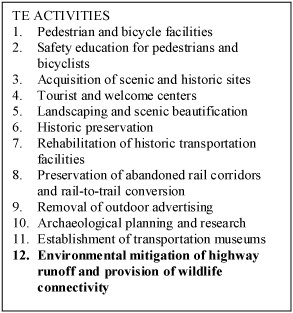
TEA-21 included
an expanded list of eligible TE activities, including
funding for provision of wildlife habitat
connectivity. Recognizing the inherent conflict
between wildlife and transportation, this category
covers projects such as wildlife crossings, underpasses
and overpasses.
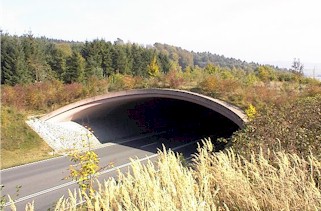
TEA-21 is up
for reauthorization in 2003, and Defenders will be hard
at work to continue improving America’s transportation
in policy and practice.
INFORMATION
TEA-21
User’s Guide
The Guide is an in-depth look at
the policies and funding contained in TEA-21. It
explains TEA-21's major features, points out key
opportunities for making progress on the ground, and
explores some potential pitfalls.
Transportation
Equity Act for the 21st Century (P.L.
105-178): An Overview of
Environmental Protection
Provisions
by Congressional Research
Service.
Intermodal
Surface Transportation Efficiency Act of 1991 -
Summary
Message by (then) Transportation
Secretary Skinner.
Federal
Highway Administration (FHWA) TEA-21 Web
site
Contains the full text, cross reference,
summaries, fact sheets, funding tables, information
exchange and publications.
|